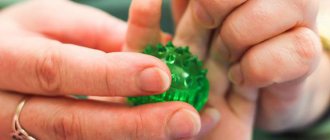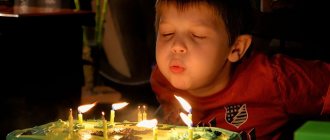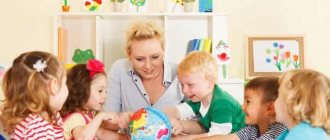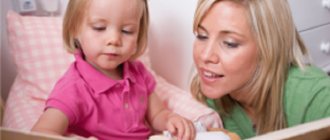One of the most common reasons for visiting a pediatric neurologist is a delay in the child’s speech development. How is a child’s speech formed? At what age should you start communicating with your baby? What are the causes of speech delay? Which doctor should I see? What examinations are carried out? How is the treatment carried out? These questions were answered by Evgenia Ivanovna Novyachkova, neurologist, epileptologist, functional diagnostics doctor at the SM-Doctor clinic for children and adolescents in Maryina Roshcha.
Normal or not?
A child should speak 1-10 words per year and know 30-60 words in the passive.
This is information from the Children's Speech Data Fund of the Russian State Pedagogical University named after. A.I. Herzen, you can trust them. If the child does not meet them, this is a cause for concern. But I recommend paying attention not so much to the active vocabulary, but to whether the child understands the spoken speech and responds to simple speech instructions. For example, “bring a bottle” - goes to where the bottle usually stands, “let’s go wash our hands” - goes to the bathroom, imitates washing hands. At one year of age, a child should know his name and easily communicate and interact with parents and children on the playground.
It happens that a child is silent until he is three years old, and then he starts talking. These are hoarding children: they understand everything, communicate with gestures, but speak little. Still, I think they are not completely silent, they say a few words.
There is such a hypothesis: modern children are “too smart” - they understand that they cannot do it the way adults do, and accumulate a passive vocabulary. But, in any case, this is a reason to contact a speech therapist. Although each history of speech development must be considered individually, each child has his own pace of development, but ontogenesis is the same for all.
Let's say that a child began to speak after three years, this does not mean that there will be no losses. In other words, if everything had been on time, the child’s level of development would have been higher. Such children usually have delays in speech and, possibly, psycho-speech development. And if speech begins to develop as if suddenly and intensely, then such rapidity is often accompanied by stuttering.
When to sound the alarm and should you take medications?
Let us note the so-called “reference points”:
- 3-6 months - the child tries out the articulatory apparatus in action and makes many sounds.
- 1 year – the first words “mother”, “give”, with a good rate of development up to ten words.
- 2 years – constructing a simple phrase of 3-4 words.
- 3 years - a common phrase, the child speaks a lot and well, reads poetry by heart.
- 4 years – the phrase is constructed taking into account grammar, using all parts of speech.
- 4-5 years – speech takes the form of a short story. The beginning of the formation of phonemic hearing.
- 5 years – speech is formed, we can say that this is the speech of an adult. The child pronounces all sounds.
- 6 years – well-developed coherent speech.
By the beginning of school, a child’s speech is normally fully formed and developed so much that it moves to the level of formation of reading and writing, and from the end of the second grade - to the level of formation of written speech.
All specialists who deal with children's speech are well familiar with the scheme of the systemic development of normal children's speech by speech therapist N.S. Zhukova, compiled from a collection of scientific works by the famous Soviet linguist A.N. Gvozdev “Issues in the study of children’s speech” (1961), which describes the longitudinal course of his son’s children’s speech. This detailed and high-quality scheme for describing children's speech is still the most popular. But, since Gvozdev’s sphere of scientific interests were phonetics and morphology, the scientist did not record understanding of speech, and detailed systematic records of the lexicon begin only from 1 year 8 months.
2.6 is the age when it is already possible to diagnose a functional delay in speech development. At this age, typical children speak in long, common sentences. If this is not the case, my recommendation is to show the child to a good speech therapist, because there is already a clear speech delay.
Parents' attention to baby babble and child speech development
If doctors decide that there are no problems with the child’s development, you can take some measures yourself to stimulate the child’s speech. Everything that I describe below is done intuitively by every mother, but these recommendations will help you act more purposefully. Note: After six months, the child begins to develop an understanding of the speech of others (impressive speech). This aspect of speech development, which is closely related to thinking, play, objective activities and socialization of the child, together with active/expressive speech, serves the child’s communication with others. This means that speech needs to be developed in the process of communication and joint play between a child and an adult.
conclusions
The study demonstrated the possibility of effective outpatient treatment of patients with speech impairment. The following results were obtained. 1. The use of Cortexin promotes regression of neurological symptoms, accelerates the rate of speech development and improves speech quality. 2. In children who received Cortexin as part of complex treatment, vascular dystonia was compensated more quickly, and CVR indicators normalized. Thus, the use of Cortexin is justified, effective and can be recommended for the treatment and comprehensive rehabilitation of children with speech disorders in an outpatient setting.
Boom stimulation
- Draw your child's attention to your face. Call him, blow, cluck to the baby, waiting for his gaze.
- Talk to your baby, conducting a kind of dialogue with him. When making sounds reminiscent of humming or cooing, pause to give your baby the opportunity to respond to you.
- Repeat the sounds your baby makes. Remember that a “talking face” is the most powerful stimulus for attracting a child’s attention. At this age, children enjoy smooth, melodious speech. They listen carefully to the intonation, not yet understanding the meaning of the speech.
- Be attentive to your child's signals; perhaps he also wants to communicate with you. This is evidenced by his look, smile, cooing sounds.
- While talking to the baby, tickle him and stroke him. Your speech and your smile, combined with tactile-motor stimulation, will help your baby smile at you. In addition, such “inhibition” stimulates the revitalization complex.
- If a child looks away, turns away, or puts his hands behind his head, this is a signal that he is tired and you need to take a break from communication.
Literature
- Zueva L.N., Shevtsova E.E. Speech therapist's handbook. M.:AST, Astrel, 2009; pp.41-2, 68, 262.
- Child Behavioral Neuroscience. Guide for doctors. Ed. L.S. Sensitive. St. Petersburg: Nauka, 2009; pp.83-109.
- Vinarskaya E.N. Dysarthria. M.: AST, Astrel, 2009; pp.136-7.
- Neurology of childhood. Ed. G.G. .Shanko, E.S. Bondarenko. Mn.: Higher School, 1985.
- Lesny I. Clinical research methods in child neurology. M.: Medicine, 1987.
- Radiation diagnostics in pediatrics: national guidelines. Ch. edited by A.Yu.Vasiliev. M.: GEOTAR-Media, 2010; pp.65-70.
Stimulating babble
- Play with your baby while sitting face to face. To do this, you can use a special chair with an inclined back (children's chaise longue, car seat). Sitting comfortably, your child will be happy to play with you.
- Repeat after your child the sounds he makes. Pause to give him the opportunity to respond to you.
- While your baby is making long vowel sounds, place your index finger under his lower lip and help him close his lips. Repeat these movements so that the child pronouncing a gets the syllables ba-ba-ba.
- Encourage your baby to put comfortable toys in his mouth. They create additional stops in the mouth, which also stimulates the appearance of syllables with consonants.
- Use a combination of chains of movements with chains of syllables: when pronouncing syllables, for example, ba-ba-ba, ma-ma-ma, jump with the child. To do this, you can sit the child on a large ball, another springy surface, or simply on your lap.
- Shake and toss the baby, this usually makes him laugh and shout loudly.
- Imitate the babble of a baby. Try to fully maintain the pace, timbre and pitch of the child’s speech. When pronouncing labial sounds and syllables, draw the child's attention to your mouth. Pause to give your child time to repeat the sounds.
- If possible, record the babbling speech of another child and let your baby listen to it. If your child has periods of active vocalization, usually in the morning, record your child's “speech” and give it to him to listen to.
Finger and gesture games
Scientists have found that in the brain, the nerve centers responsible for the movements of the fingers and hands are in close proximity to the areas of the brain responsible for the development of speech. Therefore, it is simply necessary to promote the active actions of the baby’s fingers and hands. Finger games are wonderful helpers in this matter.
In addition to funny rhymes, it is very useful to learn simple gestures with your baby in the meantime, for example:
- To the question “How old are you?” We show the index finger - “1 year old”;
- We shake our index finger “Ay-ay-ay”;
- We show “yes” and “no” by moving our heads;
- We show “thank you” with a nod of the head;
- To the question “How are you doing?” We show our thumb - “Wow!” ("Great!")
- We depict how the bear walks (feet shoulder-width apart, trampling from foot to foot);
- We depict how a bunny jumps (arms in front of the chest, hands down, jump);
- We depict how a fox walks (wiggle its butt);
- We depict how a wolf clicks its teeth (we open and close our mouth wide, clicking our teeth);
- We depict how a butterfly flies (waving our arms, running around the room);
- We depict how an airplane flies (arms motionless to the sides, we run around the room);
- We depict how a duck walks (we move on our haunches).
- As we approach two years of age, we begin to learn a new answer to the question “How old are you?” and we train to show the index and middle fingers at the same time - “2 years old”. The same finger figure can be called “Bunny”
Breathing game exercises aimed at training speech exhalation
One of the very first and very useful articulation exercises that a one-year-old baby can handle is blowing. So, how can you master the blowing skill:
- The wheel burst. First, we clasp our hands in a circle in front of us, depicting a wheel. Then, as you exhale, we begin to slowly cross our arms (so that the right hand rests on the left shoulder and vice versa) and say “sh-sh-sh” - the wheel deflates.
- Pump. Next, we invite the child to pump up the deflated tire. We clench our hands in front of our chest into fists, as if we were holding a pump. We lean forward and lower our hands down, accompanying our actions with the sound “ssss”, repeat several times.
- Loud quiet. We pronounce a sound loudly and quietly. For example, first we pretend to be big bears and say “Uh-uh,” then we pretend to be little bears and say the same thing, only quietly.
- Woodcutter. First, we put our hands together (as if we were holding an ax) and raise them up. Then we sharply lower them down, bending over and saying “uh.” We repeat several times.
- Wizard . First, we wave our hands and hold them at the top. Then we smoothly lower it, pronouncing the syllables: “M-m-m-a”, “M-m-m-o”, “M-m-m-u”, “M-m-m-y”.
- We blow on pieces of paper napkin, cotton wool, through a straw into water - we blow bubbles
- We blow out the candles - of course, under the strict supervision of adults
- We make aids on strings - paper butterflies, clouds, snowflakes, and blow on them
- We launch boats with paper sails from plastic cups into a bowl of water and blow into the sails
- We show the “breeze” - we blow on each other
- Blowing feathers and ping pong balls off the surface
- We blow through a straw into a bottle covered with a lid with foam balls.
Articulation exercises
Articulation exercises can be practiced from about 1.5 years of age, and some things may be possible even earlier:
- "Hide and seek." First we show our tongue - stick it out as far as possible, then hide it, repeat this several times.
- "Watch." Move the tongue from side to side - left and right.
- "House". We declare that the baby’s mouth is home. The mother gently taps her finger on the cheek: “Knock, knock,” and the baby’s mouth opens. We say: “Bye! Bye!” and his mouth closes.
- "Yummy". We open our mouth slightly and lick ourselves: first we run our tongue along the upper lip, then along the lower lip.
- "Balloon". We puff out our cheeks and burst them with our fingers;
- "Fence". We show our teeth (“bar our teeth”) and say that the tongue is hidden behind the fence.
- “Brushing our teeth.” We show the teeth again, then with the tip of the tongue we slide first along the upper teeth, then along the lower ones.
- "Horse". We “clop” our tongues like horses.
- “They made a mistake.” We stand together in front of the mirror and begin to express ourselves: smile widely, frown, stretch out our lips.
Onomatopoeia with repetitions is useful to do at different tempos:
How does the car sound? Beep beep! How does a cow moo? Moo-moo-moo! How does the drum beat? Ta-ta-ta! How does mom sing a song? La-la-la! How does a chicken peck grain? Kluk-klu-klu! How does the pipe play? Doo-doo-doo!
Games for speech development
You can sculpt from plasticine, play with cereals, buttons and pebbles, and paint with your fingers. You can accompany these activities with rhymes in which the baby must help the mother. These are the well-known “geese-geese”, the clumsy bear and short poems and nursery rhymes.
Many children like children's songs, which they try to repeat with pleasure. Play songs for your child to go with him. After such regular classes, speech will begin to actively develop, all you have to do is help the baby master it.
Role-playing games
Role-playing games are a very fertile environment for speech development. During the game, a child has a natural need to say something: he needs to somehow name the main characters of the game and their actions, express his thoughts and feelings.
Viewing Doman cards or other material that expands a child’s horizons
I really love the Doman method - not the one in which parents chase results and the child sees nothing else except cards, but the version where parents show the child really interesting information without fanaticism. With this approach, the child loves the cards and looks at them with pleasure. He also tends to repeat the words he heard while watching!
Developing attention
Games that develop attention and phonemic awareness (the ability to distinguish sounds). For example, “What did the bunny play on?” Show your child a bunny, some musical instruments (whistle, bell, pipe, drum, etc.), how they play.
Then cover the hare with a screen or blindfold the child and play some instrument. The kid must guess what the bunny is playing on. Even if the child does not speak, he will show a musical instrument, depict something with onomatopoeia: “ding-ding” or “boom-boom.”
You can play the game “What does it sound like?” Take various objects: paper, pencil, scissors, hammer, etc. Also, first show how something sounds, then cover it with a screen, and let the child guess. This develops observation and interest. And even more difficult - take jars with different cereals: buckwheat, rice, semolina, etc. If, of course, the child knows what it is. I know from experience that semolina is very difficult to guess. Children who are hearing impaired practically cannot hear semolina.
Theatrical games : “Who is screaming?”, “Who lives in the house?”. First we imitate an animal, for example we shout “ku-ka-re-ku”, then the baby repeats. Here you can already memorize the verb forms of two or three animals. For example: “How does a dog scream? Bow-wow. So what is the dog doing? Barks", "How does a frog scream? Kwa-kwa. What is the frog doing? It's croaking."
Little by little, verb forms enter the baby’s speech. So gradually he will learn to form a verb from one onomatopoeic word, and this is very important.
Because if in the younger group the child does not remember simple verbs, then in the middle and older groups he will not remember complex ones: the mouse squeaks, the cow moos, the cat meows, etc. Often, even in the preparatory group, children say that a cow hums and a mouse beeps.
If there are a lot of people, you can play Guess by Voice. The child closes his eyes, one of the children shouts: “Aw!” And the kid must guess who it is. Sometimes we even play this way with older children at holidays. Children call their mothers, saying simply: “Mommy!” And every mother should recognize the voice of her child. By the way, not a single mother has ever been deceived. In the same way, you can take toys, dolls that make different sounds, and guess which toy played.
Learning to listen
As a rule, modern children do not know how to listen. Audio recordings with sounds of nature, children's poems and fairy tales will help teach them this Children must turn them on and then, to make sure he listened carefully, ask questions like: “Who is the main character?”, “What is the poem about?”, “Why did this happen in this work?”, “What did you hear, rustling?” leaves or the sound of water?
This develops attention, memory and thinking. It is very important. After all, when we read, we show the child the book, and all his attention is on the pictures. Visual perception works, but auditory perception is turned off at this moment. The baby remembers what is drawn in the picture, but the pictures do not always correspond to what is said.
It is necessary to teach the child to listen to the speech of others, compare his speech with the speech of adults, and control his speech. Therefore, adult family members must pronounce all words correctly and in no case lisp with children. Children also begin to lisp and softly pronounce consonants. Even if your child really softens consonants, talk to him like an adult, without babying.
Vision vitamins for child speech development
Of all the known children's vitamins, the safest and most effective are those produced by Vision. They become a reliable help in eliminating speech defects or “spurring” its development. In addition, they allow you to supplement your diet, which does not always include all the vitamins and minerals children need for the brain and nervous system.
Vitamins from the manufacturer Vision have all the necessary qualities:
- have a natural, herbal composition;
- do not contain dyes, flavoring additives, stabilizers and other synthetic components;
- allergies and overdose are excluded;
- have a high degree of absorption (98%), as well as a synergy effect, when each component enhances the effect of the other;
- meet the strict requirements of international quality standards (GMP and ISO22000);
- certified by the Ministry of Health of many states in which the products are sold.
Vision also produces a large number of other products, for example, skin vitamins for children, or vitamins with iron, etc. Store consultants help customers choose the right combination of drugs.









